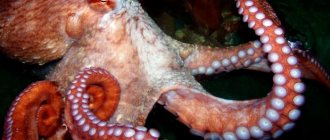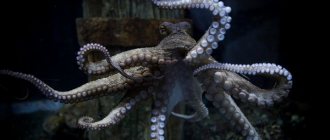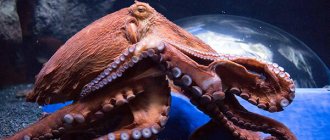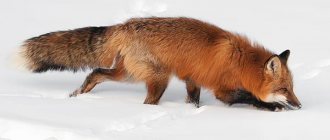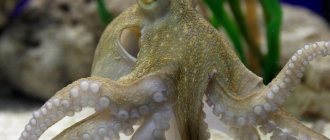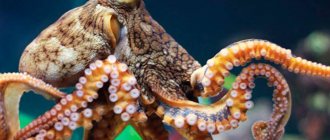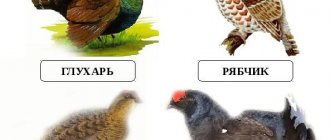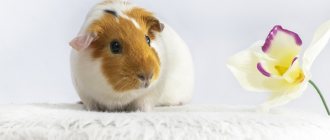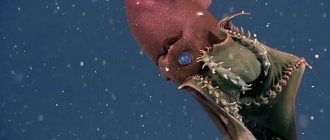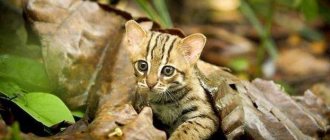The octopus is a member of the family of cephalopods. It is popularly known as an octopus, as it has eight huge tentacles. Since ancient times, there have been many legends and myths about this inhabitant of the seas. For example, sailors believed that a giant octopus-kraken lived in the ocean, capable of dragging an entire ship under water. These representatives of cephalopods form two suborders: deep-sea octopuses (Cirrata) and true octopuses (Incirrata).
The size of most octopuses does not exceed half a meter; only the common octopus, Apollyon, Hong Kong and Doflein octopus are considered large. Some species are poisonous. They live in subtropical and tropical seas and oceans, most often in coastal rocky areas. They feed on crustaceans, mollusks and fish. Octopuses breathe through gills and can remain out of water for a short time.
The most intelligent of invertebrates
The unusual appearance of the mollusk has made it the hero of many horror films. Indeed, there is something to be afraid of here.
1. Body. Resembles a soft bag filled with mucus. Short, oval. Most often red, brown or yellowish. But octopuses instantly change color when they touch this or that object.
2. Tentacles. Some call them “hands.” Others use their feet. However, the tentacles perform the function of both arms and legs. They are attached directly to the head. Hence the name of the genus – “cephalopods”. Between them there is a thin membrane.
Each tentacle is equipped with suction cups. In total, there are about two thousand suckers on the “hands” of an adult. With their help, the invertebrate easily clings to objects and moves. These tentacles have enormous power. They contain taste and visual receptors. With their help, he finds food and also determines the color of the object. That's why it transforms quickly.
3. Mouth. In a mollusk it is located at the junction of the tentacles. Two powerful jaws more closely resemble the beak of a bird than the mouth of an invertebrate. And the food is ground in the throat, where there is a kind of grater.
4. Respiratory and nervous system. The octopus breathes with gills. But it can be out of water for some time. The clam has three hearts. One circulates blue blood throughout the body. The other two are responsible for the blood supply to the gills.
Only the octopus has a brain with rudiments of the cortex. For this reason, he is called highly developed, intelligent.
5. Vision and hearing. On the head-body there are large eyes with a human lens and a rectangular pupil. Mollusks see and hear perfectly. Even infrasound is subject to them.
This appearance has led to the creation of “horror stories” about invertebrates. In reality, mollusks are harmless and intelligent. Although some of them are very poisonous.
Useful properties of the product
Octopus meat is a valuable food product. The beneficial elements included in the composition are much easier and faster absorbed by the human body than, for example, substances from beef meat. Due to its high protein content and minimum carbohydrates, seafood is used as an integral part of a healthy diet.
In addition, octopus meat can cover the daily requirement of Omega-3. The choice between nasty fish oil and a tasty delicacy is obvious. It is better to eat a small amount of seafood than to stuff yourself with a noxious-smelling liquid. The effect (beautiful skin, nails and hair, improved memory, digestion, etc.) is the same, but the process is radically different.
The octopus holds the record for the presence of copper. Copper is involved in all metabolic processes in the body, supplies cells with oxygen, promotes the formation of hemoglobin and red blood cells, helps absorb proteins and carbohydrates, affects insulin activity, and increases the protective function of the immune system.
The beneficial properties of octopus include:
- normalization of the cardiovascular system;
- improving the functionality of the gastrointestinal tract;
- positive effect on the organs of vision;
- improving brain function;
- cosmetic effect (improved condition of hair, nails and skin);
- slowing down the aging process;
- rapid increase in muscle mass;
- weight loss due to the removal of fat and water;
- prevention of atherosclerosis;
- normalization of blood pressure;
- memory improvement;
- protection against depression and nervous tension;
- prevention of oncological pathologies;
- stimulation of brain activity.
Why does the octopus have such a name?
Why was the octopus called an octopus? There are two answers to this question:
Because “eight legs”. “Eight” in Old Russian sounded like “oce”. And this representative of invertebrates has eight tentacles that perfectly perform the functions of legs. True, a ninth full-fledged tentacle periodically appears. But it is necessary for procreation. The octopus leaves it in the female's body.
There are other living creatures named one way or another based on the number and type of legs. It is enough to remember why insects are called that or why the centipede became a centipede.
Because it has an “axis”. The structure of the mollusk is axial. The tentacles are symmetrically located around its body, like around an axis. Similar body characteristics are found in rare animals, so biologists study them with interest.
The second explanation is considered more likely, since octopuses with six “legs” are found. Some associate the unusual number of tentacles with genetic abnormalities. Other biologists consider this a completely normal phenomenon.
The octopus is an interesting inhabitant of the underwater world, which is known primarily for the presence of a large number of tentacles. According to experts in the field of studying marine animals, this was the reason for its unusual name.
Character and lifestyle
Octopuses prefer to stay close to the seabed among algae and rocks. Juveniles like to hide in empty shells. In the daytime, mollusks are less active, due to which they are considered to be nocturnal animals. The octopus can easily move on hard surfaces with almost any slope thanks to its strong tentacles.
Often, octopuses use a method of swimming in which the tentacles are not used - they draw water into the cavity behind the gills and move, pushing it out with force. When moving in this way, the tentacles stretch behind the octopus.
But, no matter how many swimming methods an octopus has, they all share a common drawback - the animal moves slowly. During a hunt, it is almost impossible for it to catch up with prey, which is why the octopus prefers to hunt from ambush.
If there is no free crevice in the habitat for arranging a “home”, octopuses choose any other “room”, the main thing is that the entrance is narrower and there is more free space inside. Old rubber boots, car tires, boxes and any other objects found on the seabed can serve as homes for mollusks.
But, whatever the dwelling, the animal keeps it strictly clean, removing debris outside with the help of a directed stream of water. In case of danger, octopuses tend to immediately hide and hide, releasing behind them a small stream of ink that is produced by special glands.
Octopus and his ink
The ink hangs in a slowly growing stain that is gradually washed away by water. It is generally accepted that in this way he creates a false target for the enemy, gaining time to hide.
There is another distracting maneuver that octopuses use against enemies: if one of the tentacles is grabbed, the mollusk can throw it back with muscle effort. The severed limb makes involuntary movements for some time, distracting the enemy.
The mollusks survive the cold season at great depths, returning to shallow waters with the onset of warmth. They prefer a solitary life close to other octopuses of the same size. Thanks to the developed intelligence of the octopus, it can be tamed; moreover, it will recognize the person who feeds it among other people.
origin of name
The name “octopus”, used in Russian, is associated with the presence of eight limbs in this mollusk: thus, this term was customary to designate an animal with eight legs.
Moreover, the specific pronunciation was due to the fact that in ancient times in the Slavic language the number “eight” was pronounced as “osm”, on the basis of which this name was formed. It is noteworthy that an absolutely identical etymology is characteristic of the name of this mollusk in other languages, in which word formation followed its own path. Thus, the generally accepted name among specialists studying these animals is octopoda: a Latin word formed from two roots. The first of them also means the word "eight", and the second - "leg".
How do they reproduce?
In most octopuses, reproduction occurs only once: having given birth to offspring, they die from exhaustion.
Cephalopods mate in the following way: the males release spermatophores into the mantle cavity of the female, inserting a sexual tentacle, the hectocotylus, into one of the siphon openings. The fluid released by the male enters the female's oviduct and fertilizes the eggs during laying.
Octopuses
At the same time, octopuses belong to the octopus family, so calling such a mollusk an octopus would also be quite fair.
Each such octopus has a soft, bag-like body equipped with eight “legs” - tentacles. These tentacles, in turn, have special suction cups that help them grab prey or perform other actions, such as moving along the bottom. Moreover, each octopus, in addition to suckers, has another interesting device - an ink sac, which is a special gland that produces a black liquid. If the mollusk senses danger, it throws it out of the bag and, taking advantage of the fact that the water surrounding it has become opaque for some time, quickly swims away from the dangerous place.
The diversity of species of these mollusks living in the seas and oceans is very large, so they can differ significantly from each other in weight and size. Thus, the smallest octopuses living near the island of Sri Lanka are about 3 centimeters in length and weigh only a few tens of grams. The largest octopuses live in the Pacific Ocean: their weight can reach 9 meters, and their mass can be 250 kilograms or more.
At the same time, scientists have proven that not all of the eight “legs” the octopus has are actually legs: after long-term observations, during which the vital activity of more than 2 thousand of these mollusks was analyzed, the researchers were able to establish that only the function of the legs, that is, the limbs used For movement, only two tentacles are used. The remaining tentacles are more focused on various types of grasping movements, that is, in fact, in their functions they are closer to the hands, although they can also be used to move along the surface.
Attention, TODAY only!
Everything interesting
Sea scallops (lat. Pectinidae) of edible species are objects of fishing and artificial breeding. Scallop dishes are very popular and are served in many restaurants in Europe, Asia and America. Choose your Seafood recipe...
Eating live octopuses even today is considered unheard of exotic in all countries except Korea, where this dish is a delicacy. Despite their unattractive appearance, long tentacles and hard body, live octopuses are readily consumed in…
There are a huge number of highly organized creatures on the planet that live not only on land, but also in the water column. One of these representatives are mollusks. General characteristics The class of cephalopods, or Cephalopoda, ...
Molluscs, or soft-bodied mollusks, are a type of invertebrate animal. Their body consists of soft tissues; they often have protective horny formations like a shell. About ten classes of the Mollusc type are known. Instructions 1The body of the mollusk is not divided into segments,...
The marine world is very interesting and diverse. It is impossible to know about all its inhabitants - even a lifetime is not enough for this. However, some features, for example, the methods of movement of marine animals, are very interesting to study. Instructions 1Starfish…
Octopuses are the oldest inhabitants of the deep, believed to have outstanding mental abilities and amazing body structure. The octopus’s eyes have an unusual structure and sensitivity to light for marine life, which allows...
Sea angels belong to the family of pteropods. These creatures have a very unusual body structure and coloring. It was the appearance of the mollusk that became the reason for its unusual name. General information Sea angels are mollusks with a special structure...
The unusual name “Veresen” is a word from the Ukrainian language. It is used to designate one of the autumn months, and its origin is associated with natural phenomena. Veresen is the Ukrainian name for the first autumn...
An octopus is one big muscle. The larger the octopus, the tougher the meat. In order for the meat of this cephalopod to be soft, juicy and tender, it must be properly cleaned and prepared. Instructions 1Fresh octopus should...
We are so accustomed to the names of existing things that we hardly think about where they came from. Nobody asks why stars are called stars, the Sun is called the Sun, and the Earth, the planet on which we all live, is called Earth. Perhaps,…
The simplest thing you can draw with your child is an octopus. The first tool with which a child can create a colorful and original masterpiece is his palm. You will need - a set of finger paints; - watercolors...
There are several structural features of the snail that not everyone knows. Without them, the drawn snail will not cease to look like itself, but an experienced eye will immediately notice that an error has crept into the drawing. To avoid this when drawing a snail, follow these simple...
The octopus is a representative of the order of marine mollusks belonging to the class of cephalopods. All individuals are characterized by a sac-like body. Further in the article we will find out the characteristics of these animals, how many legs an octopus has. Photos of shellfish will also be provided...
How much do you know about octopuses? Besides the fact that they have eight legs? For example, do you know how many hearts an octopus has? Yes, yes, the question was asked absolutely correctly. After all, an octopus has not one heart, but several! Or what are these creatures capable of? Let's...
When you mention shellfish, everyone probably first of all remembers ordinary snails, while others remember gastronomic delicacies. Meanwhile, this is a separate type of animal, including a very large number of species that are completely different from each other, including...
The name “octopus”, used in Russian, is associated with the presence of eight limbs in this mollusk: thus, this term was customary to designate an animal with eight legs. Moreover, the specific pronunciation was due to the fact that in ancient times in the Slavic language the number “eight” was pronounced as “osm”, on the basis of which this name was formed.
It is noteworthy that the name of this mollusk is absolutely identical in other languages, in which word formation followed its own path. Thus, the generally accepted name among specialists studying these animals is octopoda: a Latin word formed from two roots. The first of them is also “eight”, and the second is “leg”.
Use in cooking
Octopus masterpieces are an affordable pleasure that do not require any special cooking skills. Professional chefs use only fresh seafood.
If you are cooking fresh octopus meat, be sure to remove the ink sac.
If it is not possible to purchase a fresh carcass, then the best option is fresh frozen octopus. The carcass has already been cleaned of blood, eyes, and beak and is completely ready for culinary experiments.
The carcass must be properly defrosted so that the product does not lose its nutritional value and special taste. The defrosting process should not be quick (this is how the beneficial properties of the product are lost). Leave the octopus in the refrigerator for several hours (preferably overnight). The carcass will begin to gradually thaw and within 5-8 hours (depending on size) it will become suitable for consumption.
The cooking process is extremely simple. All parts of the body (carcass and tentacles) are used in cooking, so octopus can be called a waste-free product. If you purchased baby octopuses (small size), cook them whole. If the octopus does not fit into any container in your home, then carefully cut it up.
Tip: to easily clean and separate the carcass, you need to place the octopus in hot water for 1-2 minutes.
The carcass must be boiled for 3 minutes, and the tentacles for 7 minutes. This is where the primary processing of the product ends. Boiled body parts can be used for frying, stewing, grilling or steaming. Octopus is used for kebabs, salads, appetizers, and main courses. The variety is limited only by your imagination, the necessary equipment and culinary skills.
Seafood and red pepper pasta recipe
We will need:
- durum wheat pasta – 500 g;
- seafood – 1 kg;
- olive oil – 5 tablespoons;
- garlic – 3 cloves;
- red capsicum – 1 piece;
- tomatoes – 5 pcs;
- salt and ground black pepper to taste.
Preparation
Cook the pasta until al dente (the pasta is not fully cooked, slightly hard). Use a deep cast iron frying pan, heat the olive oil, reduce the heat and fry the garlic and red capsicum. Increase the heat (when the garlic begins to lightly golden brown) and add the seafood to the pan. The olive oil should completely cover the ingredients. Mix well, reduce the heat again and leave the mixture to simmer for 3-5 minutes. Finely chop the tomatoes and add to the pan. The resulting mixture can be salted and peppered to taste. Bring the ingredients in the pan to a boil, then set the heat to low and leave the contents for 10 minutes. The tomatoes should turn into a tender tomato paste that completely covers the seafood and brings out its special taste. Add the pasta to the pan (after draining it in a colander), stir well and remove from heat after 2-3 minutes.
Octopus and potato salad recipe
We will need:
- octopus – 400 g;
- lettuce leaves – 200 g;
- red beans (boiled or canned) – 150 g;
- red onion – 100 g;
- red wine vinegar - 2 tablespoons;
- soy sauce – 1 tablespoon;
- potatoes – 150 g;
- rye bread crackers – 50 g.
Preparation
Wash the lettuce leaves and cut into large pieces. Boil the beans (or buy canned ones) and add them to the salad. Boil the octopus until tender with your favorite spices, cut into cubes up to 2 cm in diameter. Cut the onion into rings. Combine all ingredients in a deep container, season with sauces. Mix thoroughly and serve.
